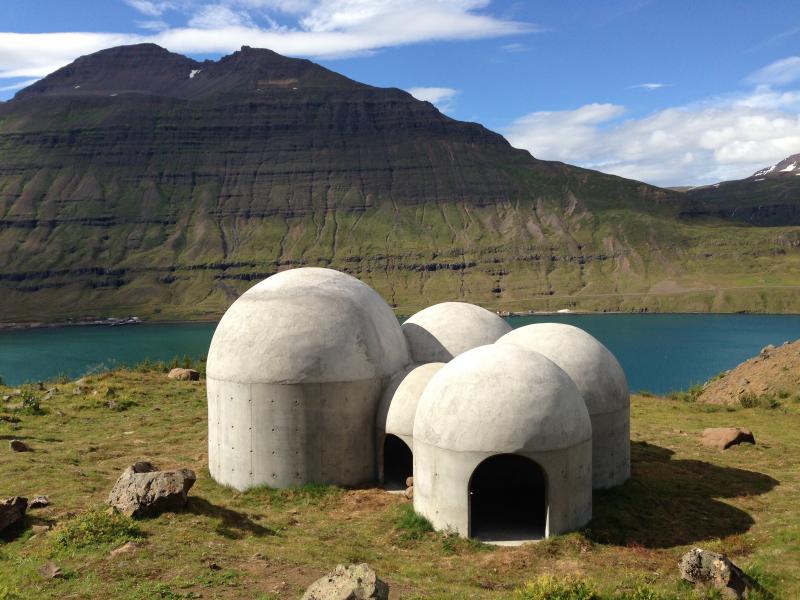Tvísöngur Sound Sculpture, Iceland (Model)
Information
Images
Impulse Responses
Acoustic Parameters
Attribution
Information
Description:
Opened to the public in 2012 and situated in the mountains above Seydisfjordur, north east Iceland, Tvísöngur is a sound sculpture designed by German artist Lukas Kuhne. Constructed entirely of smooth unpainted concrete at 100mm thick throughout, it consists of five interconnected domes – nicknamed “Fa”, “La”, “Si”, “Do” and “Mi” in order of decreasing size. Each dome’s distinct size produces an individual resonant frequency corresponding to a tone in traditional Icelandic five-part harmony. Rounded archway openings built into the walls of each dome allow visitors to enter the structure and experience the unique acoustical characteristics of the space. These arched openings also act as Helmholtz resonators, as wind blowing in off the cliffs rushes into and across the openings, the air within the structure resonates. Nicknamed the ‘singing concrete’, Tvísöngur was designed for several voices in order to preserve Iceland’s musical heritage, which was one of the first and now only surviving forms of improvised polyphonic chants in Europe. In collaboration with the artist Lukas Kühne, using ODEON acoustic simulation software, an acoustic model replica of the structure was built in order to visualise how sound propagates through the structure, investigate how certain frequencies are resonated by each individual dome, and produce simulated impulse responses to create auralizations. One source and one receiver was positioned centrally within each of the five domes at 1.5m in height. Those within the structure would most likely experience the acoustic conditions from a standing position as there is no seating, therefore a source/receiver height of 1.5m was most suitable. The only exception being dome ‘Mi’ which, due to its lower ceiling height, was lowered to 1.2m in order to be a satisfactory distance from wall boundaries in accordance with guidelines set out by ISO 3382. For each source, a receiver position was located in each of the remaining 4 domes. A total of 20 impulse responses were therefore rendered (5 sources x 4 receivers). Please see images 4, 5, 6 for more detailed source/receiver positioning. The HRTF’s used for binaural impulse response rendering were from the ODEON database, Subject_021Res10deg (Algazi, 2001).
Measurement Team:
Oliver McIntyre
Capture Date:
Mon, 27/03/2017
Size:
100.41 m³
Space Category:
Chamber
Open Air
Generation Type:
Computer Model
Images
Impulse Responses
Waveform Example
Source Position 1 (Dome “Fa”), Receiver Position 4 (Dome “Do”). Source Height: 1.5m. Receiver height: 1.5m. Source/Receiver Distance: 4.73m.
Audio Examples
Anechoic voice
Acoustic Parameters
Attribution
Attribute this work to:
Oliver McIntyre
AudioLab, Department of Electronic Engineering, University of York
www.olivermcintyre.co.uk
– – – – – – – – – – – – – – – –
Lukas Kühne
Tvísöngur Architect
www.lukaskuehne.com
– – – – – – – – – – – – – – – –
Images 1, 7, 8, 9 by Gudmundur Oddur Magnusson
Permission to use images provided by Lukas Kühne

This work is licensed under a Creative Commons Attribution 4.0 International License.
Icons by Icons8












